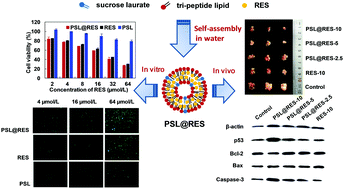Anti-breast cancer activity of resveratrol encapsulated in liposomes†
Abstract
Resveratrol (RES) is a naturally occurring and effective drug for tumor prevention and treatment. However, its low levels of aqueous solubility, stability, and poor bioavailability limit its application, especially when used as a free drug. In this study, RES was loaded into peptide and sucrose liposomes (PSL) to enhance the physico-chemical properties of RES and exploit RES delivery mediated by liposomes to effectively treat breast cancer. RES loaded PSL (the complex: PSL@RES) were stable, had a good RES encapsulation efficiency, and prolonged RES-release in vitro. PSL@RES was exceptionally efficient for inhibiting the growth of cancer cells, as the IC50 of PSL@RES in MCF-7 cells was found to be only 20.89 μmol L−1. The therapeutic efficacy of PSL@RES was evaluated in mice bearing breast cancer. The results showed that PSL@RES at a dosage of 5 mg kg−1 was more effective than 10 mg kg−1 free RES, and PSL@RES inhibited tumor growth completely at a dosage of 10 mg kg−1. PSL@RES induced apoptosis in breast tumor by upregulation of p53 expression. This then downregulated Bcl-2 and upregulated Bax, thereby inducing Caspase-3 activation. More importantly, encapsulation of RES within peptide liposomes greatly reduced the toxicity of free RES to mice. Overall, the simple formulation of liposomal nanocarriers of RES developed in this study produces satisfactory outcomes to encourage further applications of liposomal carriers for the treatment of breast cancer.



 Please wait while we load your content...
Please wait while we load your content...